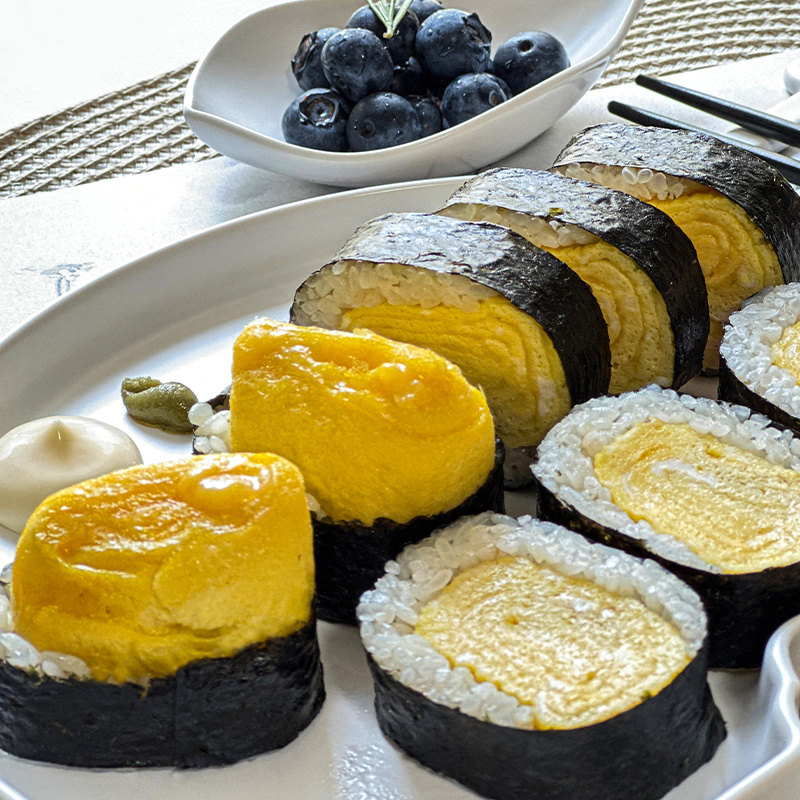Tamagoyaki Gimbap (Rolled Omelette Korean Seaweed Rice Rolls)
[Easy Korean Dish] Tamagoyaki Gimbap

Inspired by the popular Dong-a Sikdang’s tamagoyaki gimbap in Daegu, I’ve recreated a similar version! This dish offers a delightful sweet and savory balance thanks to soy sauce (tsuyu) and sugar. It’s a simple yet satisfying meal or snack that’s perfect for any occasion.
Ingredients (for 1 roll)- 1 bowl of warm cooked rice
- 1 sheet of Gimbap seaweed
- 4 large eggs
- 1 Tbsp olive oil
- 1 Tbsp sesame oil
Tamagoyaki Seasoning- 1 Tbsp sugar
- 1/2 Tbsp tsuyu (Japanese soup stock)
- 2 Tbsp milk
- 1 Tbsp mirin (sweet rice wine)
- 2 pinches salt
Sauce- 1 Tbsp mayonnaise
- 1/2 Tbsp wasabi
- 1 Tbsp sugar
- 1/2 Tbsp tsuyu (Japanese soup stock)
- 2 Tbsp milk
- 1 Tbsp mirin (sweet rice wine)
- 2 pinches salt
Sauce- 1 Tbsp mayonnaise
- 1/2 Tbsp wasabi
Cooking Instructions
Step 1
First, let’s prepare the eggs. Crack 4 eggs into a bowl. There’s no need to remove the chalazae (the white stringy bits); simply whisk them well with a fork or whisk. To ensure a thick and firm tamagoyaki that won’t crumble easily, add milk and mirin. These ingredients help create a smoother texture and act as a binder. Now, season the egg mixture by whisking in 1 Tbsp sugar, 1/2 Tbsp tsuyu, 2 Tbsp milk, 1 Tbsp mirin, and 2 pinches of salt until the sugar is completely dissolved.

Step 2
Next, it’s time to cook the tamagoyaki. Heat a wok (or a wide, flat frying pan) over low heat. Add 1 Tbsp of olive oil and use a paper towel to coat the entire surface evenly with a thin layer. If you have a dedicated tamagoyaki pan, it will be easier, but a regular frying pan or even a round cast-iron pan can work. A wok is often convenient for shaping the roll.

Step 3
We’ll be pouring the egg mixture in three batches. Pour the first thin layer of egg mixture into the heated pan. Once the edges start to change color, it’s time to flip. Even when cooking on low heat, the egg can burn if left too long, so timing is crucial.

Step 4
Using a spatula or chopsticks, carefully roll the cooked egg into a cylinder. Pour the second batch of egg mixture over the rolled egg. Cook this slowly over low heat as well.

Step 5
Don’t worry if the shape isn’t perfectly neat in the middle stages. The final roll will look great if you shape it well on the third pour. Carefully add the third layer of egg mixture and gently shape it to create a beautiful final form.

Step 6
After pouring all the egg mixture and completing the roll, use the residual heat from the pan to gently press and shape the rolled omelette with your spatula. While it’s still warm, it will hold its shape well.

Step 7
Wrap the tamagoyaki tightly with a rubber band or seaweed to secure its round shape. Let it cool slightly. This process allows the residual heat to gently cook the inside of the omelette.

Step 8
In a bowl, combine 1 bowl of cooked rice with 1 Tbsp of sesame oil and a pinch of salt. Gently mix without pressing the rice grains too hard, ensuring each grain is coated with sesame oil and salt. You can also use a pre-cooked rice pack (like a microwaveable one).

Step 9
Spread the seasoned rice thinly over about two-thirds of the rough side of the Gimbap seaweed sheet. Place the rolled tamagoyaki on top of the rice. Press down firmly and roll the seaweed tightly. A helpful tip: moisten the edge of the seaweed with a little water to ensure it seals well and doesn’t unravel.

Step 10
Almost there! Carefully slice the rolled gimbap, being careful not to tear the seaweed. Arrange the beautiful tamagoyaki gimbap on a serving plate. This is a wonderfully simple recipe – just make the tamagoyaki and roll it up! Enjoy making this delicious dish.




